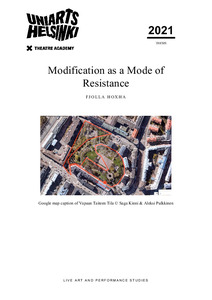Modification as a mode of resistance
Hoxha, Fjolla (2022)
Hoxha, Fjolla
Taideyliopiston Teatterikorkeakoulu
2022
Maisterin opinnäytetyö
LAPS
Julkaisun pysyvä osoite on
https://urn.fi/URN:NBN:fi-fe2022050633362
https://urn.fi/URN:NBN:fi-fe2022050633362
Tiivistelmä
Modification As a Mode of Resistance is focused on reading temporalities, and more specifically re-reading the past as a
plurality through the lens of spaces chosen for live and performance art to take place in. This artistic research has been
developed through various experiments tested via performances which I conducted during my studies at LAPS. It is a
reflective essay on the artistic research project.
I approach this written thesis through three unfolding semi-permeable maps which intersect and intertwine to lay out the
connection that I build between 1) re-reading the past. 2) re-constructing past(s). 3) re-framing / re-sensing /re – producing
spaces in my performance art works.
Taking this into account, I reflect on what tools and theoretical grounds as well as what dramaturgical and aesthetical
strategies I have utilized in my artworks and how the techniques that I have developed inform the nature of my work in the
future. My entry point towards this study is my autobiography: my memories and archives related to restrictive periods in
my life (war and oppression) which I look back at for source materials, expanding further to encounters with histories and
spaces in Helsinki and Finland, to in this way go beyond the personal.
In this written thesis I navigate through these questions: what is the potential of (the unfinished) pasts that linger through
time and space? How do they connect different histories and geographies to expose power structures, create sensitivity for
the non-familiar in the present and reshape the future? In what form can they manifest through performance and live art?
To find answers to these questions, I look at autobiography through autotheory, taking into account the plasticity and
flexibility of the memory in an intersection with theories of human geography on space production.
In the end, I argue that looking at the relationship of the chosen performance spaces to their histories, social significance,
surroundings, and accessibility reveals a valuable layer in constructing critical performances that connect the performers and
audiences in a dialectical way.
plurality through the lens of spaces chosen for live and performance art to take place in. This artistic research has been
developed through various experiments tested via performances which I conducted during my studies at LAPS. It is a
reflective essay on the artistic research project.
I approach this written thesis through three unfolding semi-permeable maps which intersect and intertwine to lay out the
connection that I build between 1) re-reading the past. 2) re-constructing past(s). 3) re-framing / re-sensing /re – producing
spaces in my performance art works.
Taking this into account, I reflect on what tools and theoretical grounds as well as what dramaturgical and aesthetical
strategies I have utilized in my artworks and how the techniques that I have developed inform the nature of my work in the
future. My entry point towards this study is my autobiography: my memories and archives related to restrictive periods in
my life (war and oppression) which I look back at for source materials, expanding further to encounters with histories and
spaces in Helsinki and Finland, to in this way go beyond the personal.
In this written thesis I navigate through these questions: what is the potential of (the unfinished) pasts that linger through
time and space? How do they connect different histories and geographies to expose power structures, create sensitivity for
the non-familiar in the present and reshape the future? In what form can they manifest through performance and live art?
To find answers to these questions, I look at autobiography through autotheory, taking into account the plasticity and
flexibility of the memory in an intersection with theories of human geography on space production.
In the end, I argue that looking at the relationship of the chosen performance spaces to their histories, social significance,
surroundings, and accessibility reveals a valuable layer in constructing critical performances that connect the performers and
audiences in a dialectical way.
Kokoelmat
- Kirjalliset opinnäytteet [1402]
